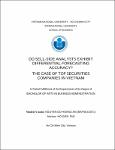| dc.description.abstract | Analysts’ equity researches can provide investors with informative updates
that may eventually results in valuable recommendations for futures gain (or loss
aversion). Lots of studies around the world has been carried out around this topic. Most
found that sell-side reports are usually biased with low level of accuracy. Consistent with
what has been suggested, firms’ Buy recommendations tends to overshoot. This paper
resembles the multi-metric evaluating methodology suggested by Bonini et al. (2010).
Error variables (IS metric and FS metric) make it possible to thoroughly examine the
accuracy level of target prices (TPs) released by the top brokerage houses (SSI, VCSC,
MBS, BSC and FPTS). The results indicate that some firms can be biased as Buy
recommendations are overshooting. However, in most of the cases, errors are randomly
distributed around the zero-mean. This paper, by adding another layer accuracy metrics
to the former tests, is able compare analysts past performance in forecasting target prices.
Results show that the forecasting ability among firms are not significantly different.
Limitations are also provided in this paper. | en_US |


